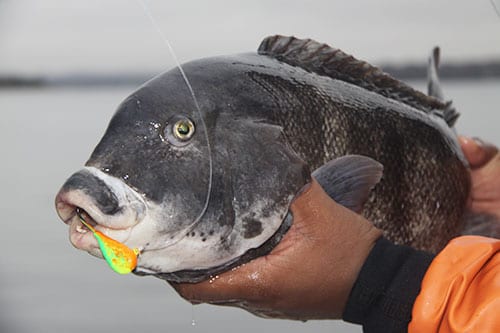
By Tom Schlichter
You’ve waited all season and now it’s finally here. With the start of October, it’s reasonable to expect the fall blitz to officially commence across the Northeast from Massachusetts to Long Island. Actually, it has quietly been building for the past few weeks as peanut bunker, spearing, bay anchovies, sand eels and other small baitfish have begun exiting harbors and tidal creeks, pursued by snapper blues. With all that fresh fodder flooding out and along the beaches, big blues and scattered pods of false albacore have begun to make more regular forays into the shallows.
As this flood of food baits continues, the action will undoubtedly intensify and striped bass should join the mix. Bottom species, too, dial up feeding activity as numbers increase with influxes from more northern waters and competition builds though month’s end. If you’ve been banking any vacation days, cash them in now.

Experienced anglers hoping for more of a rough and tumble battle need look no further than the larger blues patrolling beneath the remaining schools of adult bunker inside harbors and bays, working the depths on the Long Island Sound Middle Grounds, barreling through the rips at such famous spots at Montauk Point, The Race and Plum Gut, or crashing the shoreline at dawn, dusk and the start of outgoing tide during any part of an overcast day. These can be baited with bunker chunks, especially early in the month, but are far more challenging when duped with lures.
Tins of all varieties work for the blues, of course, but for unbeatable surface smashing thrills, toss a large yellow, white or blue bottle plug into a school of surfacing fish and hold on tight as you shake the lure violently throughout the retrieve. So aggressive are the choppers some days that anglers have been known to occasionally catch two big blues simultaneously on the same plug.

Boaters, of course, have an edge when it comes to the blues because there are often vast schools holding offshore of just outside the surf line. These fish, generally running four to eight pounds and will smash tins, wreck trolled umbrella rigs and demolish any fly pattern that incorporates a flash of sliver or white. Along the beach, the choppers can run from 2 pounds on up to ‘teen sized gorillas and alligators. The edge here goes to those timing trips to match up with the start of the ebb and rough winds from the north or northeast that kick up a nasty surf and turn the curls brown. When fishing for blues and bass from shore from now until Thanksgiving figure the meaner the surf, the better the scores.
While the choppers seem to relish roiled breakers, false albacore prefer a gentler surface that allows them to surround and herd the baitfish schools that stoke their fire. As fans of the little tunny quickly come to realize, the best way to tell these fast moving predators from bluefish is by their light splashes and accelerated pursuit as they race quickly into and then out of casting range. Light-tackle and long wand aficionados delight in hunting them down on calm days, easing quietly into position to intercept the schools, and casting slender tins along the lines of Deadly Dicks and Ava 17s, white Fin-S-Fish, Bass Assassins or sparsely tied crease flies and epoxy patterns in olive, chartreuse, tan or white.
Boaters can work rips and points for albies while surfcasters will usually do best in coves and pockets that corral the baitfish, and thus the albies, into confined stretches along the shore. Areas adjacent to inlets and harbor mouths are also good starting points.

October, of course, is also prime striper time. Expect to find plenty of bass stacked up in major rips, holding in the lee of large boulders around points, or mixed in with the blues along rocky beaches. Jig the linesiders from deep water with tubeless diamonds or bait them with chunks at the top of an ebbing tide. If working the beachfront boulder fields – from shore or boat – try tossing soft plastic stickbaits. Hogy’s 10-inch original in black, impaled on a small jig head works, works well after dark if you are hoping for a keeper. For daylight action, my favorite swimbait by far is a Panther Martin Big Fin. This lure is snagless and comes in both a 1-ounce (5-inch) and 2-ounce (7.75-inch) sizes. Simply cast out and retrieve it at medium speed with a twitch of the rod every now and then. From schoolies to cows, the bass can’t resist it. This same lure, in the white/red 1-ounce size, by the way, is also the single best false albacore lure I have ever used. For Fat Albert, reel just quick enough to keep the lure 4- to 6 inches below the surface.
Not to be forgotten in all the predatory fish mayhem is some terrific bottom action. Porgy fishing can be awesome this month and black sea bass, in case you somehow haven’t packed away enough of their fillets already, usually go on a tear. Blackfish, too, are an October treat. Early in the month the ‘tog move into rocky waters, sliding from deep haunts into rough patches as shallow as six or eight feet deep. Start probing in 25-foot depths and follow the fish shallower for a week or two before reversing course and tracking the tough-mouthed crab eaters out to deeper waters when November rolls around.
Editor’s Note: Catch more of Tom Schlichter on his Outdoor Tom Facebook page (@outdoortomcorp). Here, you’ll also find his Outdoor Tom E-news posted every other Tuesday.









